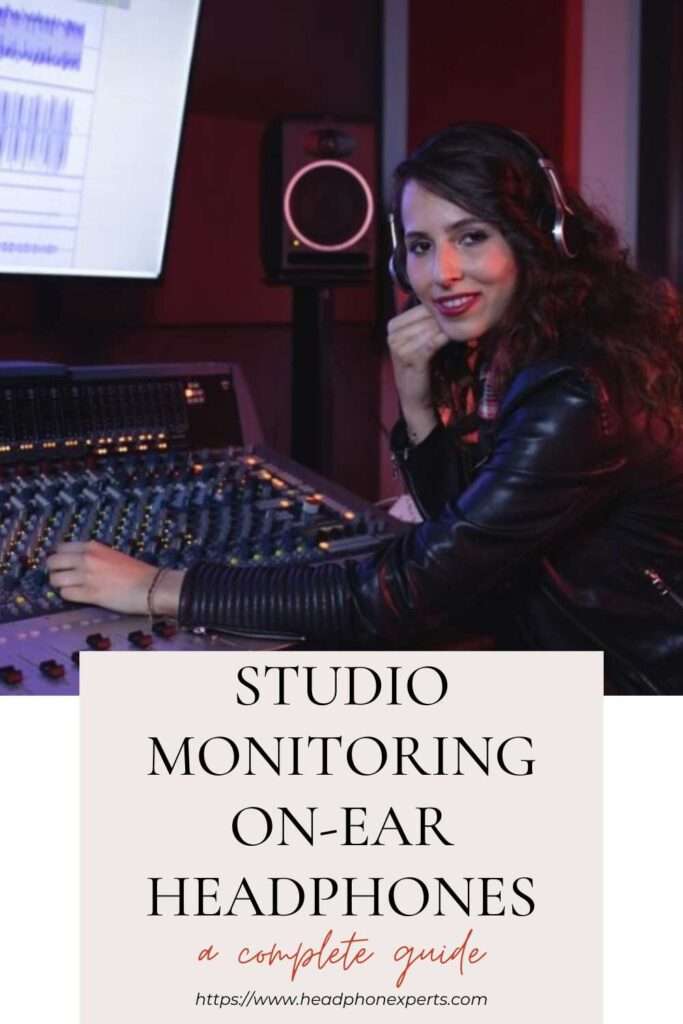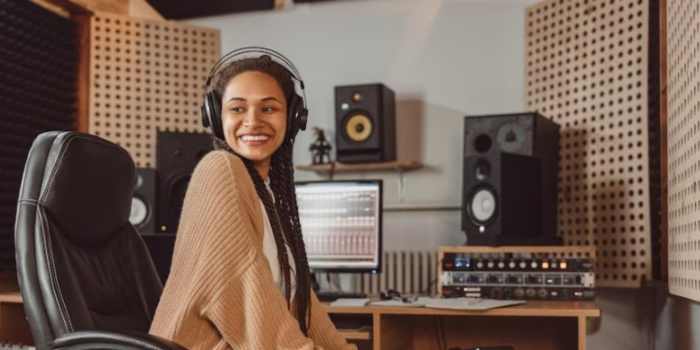Studio Monitoring On-Ear Headphones demonstrate exceptional sound integrity. These headphones are meticulously built for discerning professionals and audiophiles, resulting in a balanced blend of comfort and accuracy.
They enhance the audio experience by providing an untainted soundscape, which is vital for critical listening, mixing, and mastering in studio settings.
With great attention to detail, Studio Monitoring On-Ear Headphones redefine the standard, giving an immersive auditory experience that uncovers the nuances of every musical note with unprecedented clarity.
in this topic we will cover:-
- Why Use On-Ear Headphones for Studio Monitoring
- 5 Best Studio Monitoring On-Ear Headphones
- Key Features to Consider When Choosing Studio Monitoring On-Ear Headphones
1. Why Use On-Ear Headphones for Studio Monitoring?
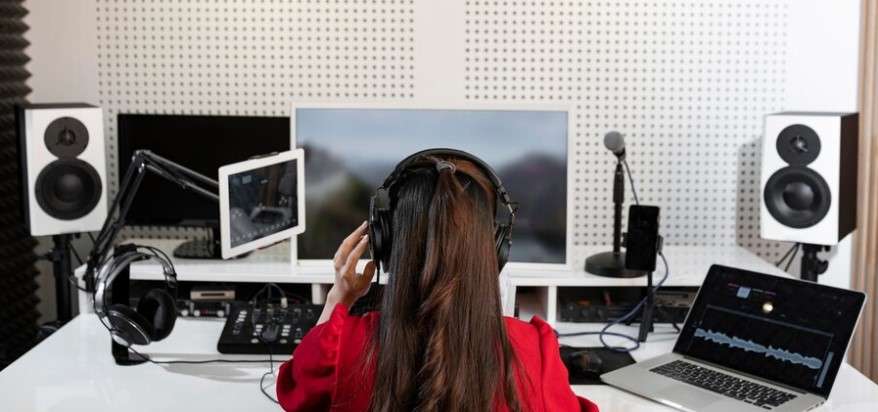
On-Ear Headphones Versus Over-Ear Headphones:
When it comes to studio monitoring, choosing between on-ear and over-ear headphones depends on comfort, mobility, and the monitoring environment’s specific requirements.
On-Ear Headphones:
- These headphones sit on the ears without entirely covering them.
- Portability: It is generally more small and portable.
- Isolation: Provides some noise isolation while allowing for ambient sounds.
- Comfort: Lightweight and cool for extended use.
Over-Ear Headphones:
- These headphones cover the entire ear, offering a more immersive listening experience.
- Portability: Larger and less portable than on-ear rivals.
- Isolation: Typically provides improved noise isolation and reduces external interference.
- Comfort: The bigger ear cups make it more pleasant for extended use.
Advantages of On-Ear Headphones for Studio Monitoring
Precision and Details: On-ear headphones are noted for their ability to reproduce sound with great detail and precision. This is critical for studio monitoring, as audio playback accuracy is essential for mixing and mastering.
Portability and Convenience. On-ear headphones are often smaller, making them a better alternative for people who need to move around the studio regularly. Their lightweight form improves portability while maintaining sound quality.
Natural Sound: On-ear headphones allow for natural sound leaking, resulting in a more immersive and realistic listening experience. This feature can be useful for retaining a link with the surrounding studio environment.
Comfort for Longer Sessions: On-ear monitors are frequently more breathable and comfortable for extended monitoring sessions. This is especially crucial for professionals who work long hours in the studio, since it ensures minimum weariness over time.
Versatility: On-ear headphones are adaptable and suitable for various studio applications. Whether tracking, mixing, or mastering, their balanced sound profile makes them suited for a wide range of studio applications.
Drawbacks of On-Ear Headphones for Studio Monitoring
Limited Isolation: On-ear headphones may offer less isolation than over-ear models. This can be a disadvantage in situations where complete separation from external noises is required, such as in busy studio settings.
Bleed and Spill: On-ear headphones’ design might cause sound bleed, which can be picked up by microphones. This can be problematic during recording sessions and necessitates careful monitoring levels.
Less Immersive Experience: The on-ear design may not provide the same level of immersion as over-ear headphones. While this may not be a major concern for studio monitoring, people looking for a more contained sound experience may choose over-ear solutions.
Potential Discomfort for Some Users: While on-ear headphones are generally agreeable, some users may find prolonged use less comfortable than over-ear choices, especially if the ear cups press too hard on the ears.
2. 5 Best Studio Monitoring On-Ear Headphones
1. Audio-Technica ATH-M50X Professional Studio Monitor Headphones
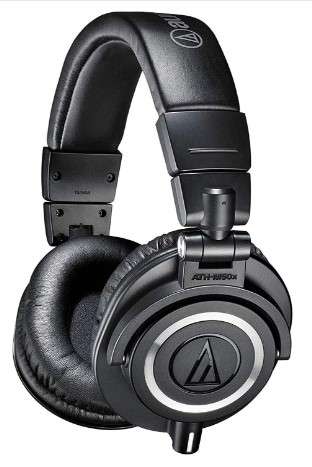
Audio-Technica’s ATH-M50X headphones have become industry standards, notably for studio monitoring. These headphones, known for their professional-grade sound, are designed to fulfill the specific requirements of studio professionals, audio engineers, and musicians.
The sleek black style adds sophistication to their functionality, making them a popular choice for both experienced professionals and budding artists. Let’s look at the benefits and downsides of the ATH-M50X headphones in the studio.
Pros:
- Professional Grade Audio Quality:
- The ATH-M50X headphones are celebrated for their exceptional audio reproduction, offering a flat, accurate response. This makes them invaluable in studio settings where precise monitoring is crucial for mixing and mastering.
- Critically Acclaimed Sound Signature:
- These headphones have received critical acclaim for their well-balanced sound signature. The clarity in the midrange, detailed highs, and tight bass response contribute to an immersive listening experience, allowing for accurate assessment of audio recordings.
- Detachable Cable for Convenience:
- The inclusion of a detachable cable is a practical feature, offering convenience and flexibility. Users can easily replace or upgrade cables as needed, extending the lifespan of the headphones and reducing the chances of cable-related issues.
- Comfortable for Extended Sessions:
- The circumaural design and plush ear cushions provide excellent comfort, allowing for extended studio sessions without causing discomfort or fatigue. This comfort is essential for professionals spending long hours in the studio.
- Collapsible Design for Portability:
- The headphones feature a collapsible design, making them portable and easy to store. This is advantageous for musicians and engineers who may need to move between different studios or workspaces.
Cons:
- Bulky Design for On-the-Go Use:
- While the collapsible design aids in portability, the overall size and weight of the ATH-M50X may be considered bulky for those looking for more compact headphones for on-the-go use.
- Limited Soundstage for Open-back Enthusiasts:
- Studio professionals who prefer a more expansive soundstage might find the closed-back nature of these headphones somewhat limiting. Open-back alternatives are generally preferred for a more natural, spacious sound reproduction.
2. beyerdynamic DT 770 Pro
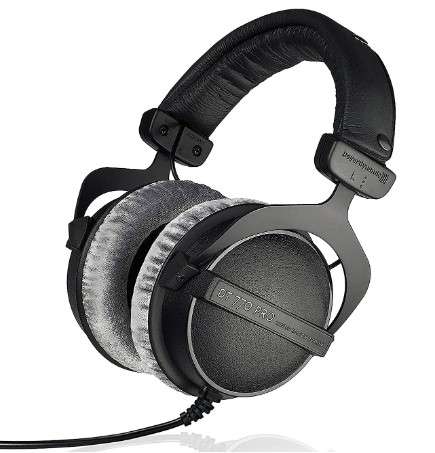
The Beyerdynamic DT 770 Pro Limited Edition Professional Studio Headphones are an impressive addition to the well-known DT 770 Pro line, designed exclusively for studio professionals and audio fans.
These headphones, known for their closed-back design and superb sound isolation, are popular in the professional audio business, providing a dependable instrument for critical listening, recording, and mixing. The Limited Edition edition builds on the success of the standard DT 770 Pro, adding small changes to improve the studio experience.
Pros:
- Outstanding Sound Reproduction:
- The DT 770 Pro Limited Edition maintains the series’ reputation for exceptional sound quality. With a wide frequency response and detailed audio reproduction, these headphones are well-suited for critical studio monitoring and mixing tasks.
- Closed-Back Design for Isolation:
- The closed-back design effectively isolates the listener from external ambient noise, providing an immersive and focused listening experience. This isolation is crucial for accurate monitoring in a studio environment, allowing for better decision-making during recording and mixing sessions.
- Comfortable Fit for Prolonged Use:
- The headphones feature velour earpads and an adjustable headband, ensuring comfort during extended studio sessions. This comfort is essential for professionals who spend long hours wearing headphones, promoting fatigue-free listening.
- Durability and Build Quality:
- Beyerdynamic is renowned for its robust build quality, and the DT 770 Pro Limited Edition is no exception. The rugged construction ensures longevity, making them a reliable investment for studio professionals who require durable equipment.
- Limited Edition Enhancements:
- The Limited Edition variant may include subtle improvements or unique aesthetic features, making them an attractive choice for users who appreciate exclusivity. Limited production runs can add a touch of individuality to these studio headphones.
Cons:
- Non-Collapsible Design:
- Unlike some competing models, the DT 770 Pro Limited Edition does not feature a collapsible or foldable design. This might make them less portable for users who prefer headphones that can be easily stowed in a bag or case.
- Fixed Cable:
- The headphones come with a fixed cable, which may pose an inconvenience for users who prefer the flexibility of detachable cables. A detachable cable system provides the advantage of easy replacement or customization.
3. Behringer HPS5000
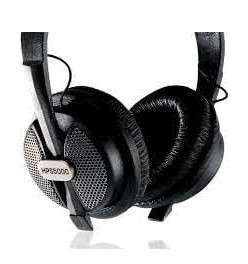
The Behringer HPS5000 Studio Headphones are intended to suit the needs of studio professionals and music fans who require precise and detailed sound reproduction. These headphones, manufactured by Behringer, a firm well-known for its audio equipment, are designed to provide a studio-grade listening experience. Let’s look at the advantages and negatives to better grasp their benefits and limitations.
Pros:
1. Wide Frequency Response:
- The HPS5000 boasts a broad frequency response, allowing users to hear a wide range of tones accurately. This is crucial in a studio setting where precision is paramount.
2. Comfortable Design:
- The over-ear design and padded headband contribute to a comfortable wearing experience during extended studio sessions. This comfort is essential for professionals spending long hours in the studio.
3. Closed-Back Design:
- The closed-back design provides excellent noise isolation, preventing sound leakage and minimizing external interference. This feature is advantageous when working in a studio environment where concentration is key.
4. Durable Build Quality:
- The headphones are constructed with durability in mind. The sturdy build ensures they can withstand the rigors of regular studio use, making them a reliable choice for professionals.
5. Affordability:
- The Behringer HPS5000 offers a cost-effective solution for those seeking studio-quality sound without breaking the bank. It provides a budget-friendly option for individuals starting in the audio production field.
Cons:
1. Bass Response:
- Some users report that the bass response may lack the depth and impact found in higher-end studio headphones. This limitation might affect the accuracy of low-frequency monitoring during audio production.
2. Plastic Construction:
- The predominantly plastic construction, while contributing to affordability, may raise concerns about long-term durability compared to headphones with more metal components.
3. Non-Detachable Cable:
- The non-detachable cable can be a drawback, especially in professional studio settings where the ability to replace cables is valued. A detachable cable design would provide more flexibility.
4. Sennheiser Professional HD 25 PLUS
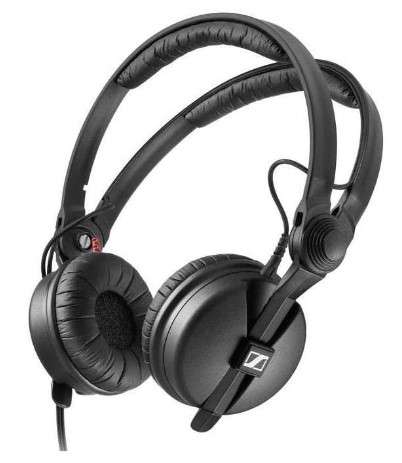
Sennheiser’s Professional HD 25 PLUS On-Ear Monitor Headphones are an audio industry standard, known for their remarkable performance and longevity. These headphones, designed with studio pros in mind, are known for providing accurate sound reproduction and isolation in high-pressure studio conditions.
With a decades-long history, the HD 25 series has become an industry standard, trusted by DJs, sound engineers, and music producers worldwide. Let’s look at the essential features, benefits, and potential drawbacks of the Sennheiser Professional HD 25 PLUS headphones.
Pros:
- Outstanding Sound Quality:
- The HD 25 PLUS headphones are celebrated for their accurate and detailed sound reproduction. They provide a clear and balanced audio profile, allowing professionals to make precise judgments during mixing and mastering.
- Excellent Noise Isolation:
- Designed as on-ear closed-back headphones, the HD 25 PLUS excels in isolating external noise. This feature is crucial in studio environments, enabling users to focus solely on the audio they are working with without interference.
- Robust Build and Durability:
- These headphones are built to endure the rigors of professional use. The split headband and sturdy ear cup construction make them exceptionally durable. Users appreciate their ability to withstand the demands of daily studio life.
- Modular Design:
- The HD 25 PLUS headphones have a modular design, allowing users to replace individual components such as ear cushions and cables. This feature enhances the longevity of the product and makes it easy to maintain over time.
- Wide Frequency Response:
- With a frequency response ranging from 16Hz to 22kHz, these headphones capture a broad spectrum of frequencies. This ensures that users can hear every nuance in their audio, making them suitable for various music genres and professional applications.
- Comfortable Fit:
- Despite their robust build, the HD 25 PLUS headphones are designed with comfort in mind. The lightweight construction and adjustable headband contribute to a comfortable and secure fit during extended studio sessions.
Cons:
- On-Ear Design Comfort:
- While the on-ear design contributes to noise isolation, some users may find prolonged use less comfortable compared to over-ear alternatives. This can be subjective, and individual preferences vary.
- Fixed Cable:
- The HD 25 PLUS comes with a fixed cable, which may be a drawback for users who prefer detachable cables for easy replacement or customization. However, the durability of the included cable mitigates this concern to some extent.
- Price Point:
- These headphones are positioned at a higher price point, which might be a consideration for budget-conscious individuals. However, the investment is often justified by the exceptional build quality and audio performance.
3. Key Features to Consider When Choosing Studio Monitoring On-Ear Headphones

Let’s look at each major element to consider while selecting studio monitoring on-ear headphones:
Headphone Sensitivity: This relates to how effectively headphones translate electrical signals into sound. It’s measured in decibels per milliwatt (dB/mW). Higher sensitivity indicates that the headphones can deliver louder sounds with less input power.
For studio monitoring, you must have headphones with the sensitivity to accurately represent the intricacies of your audio source. This ensures that delicate elements in your song or audio are preserved, resulting in a more accurate portrayal of your work.
Headphone Impedance: Headphone impedance refers to the headphones’ resistance to the electrical signal from the audio source.
It’s measured in ohms. Lower impedance headphones (e.g., 32 ohms) are typically easier to drive and work well with portable devices, but higher impedance headphones (e.g., 250 ohms and up) may necessitate the use of dedicated headphone amplifiers.
In the studio, selecting headphones with an impedance that matches your audio interface or amplifier is critical for maximum performance and fidelity.
Frequency Response: Headphones’ frequency response determines the range of sounds they can reproduce. A flat and wide frequency response is ideal for studio monitoring since it ensures that the headphones faithfully replicate the whole range of audible frequencies.
Look for headphones that have a balanced response in the bass, midrange, and treble frequencies. This is essential for precise mixing and mastering, allowing you to make educated decisions about the tonal balance of your audio.
Noise Isolation: Headphones have the capacity to block out extraneous sounds and prevent sound leakage. In a studio setting, it’s critical to have headphones that provide adequate noise isolation, allowing you to concentrate on your job without being distracted by background noise.
Closed-back on-ear headphones are commonly used for studio monitoring due to their ability to provide passive noise isolation.
Comfort: Comfort is essential, especially for long studio sessions. Look for headphones that have adjustable headbands, comfortable ear cushions, and are lightweight to provide long-term comfort.
Comfortable headphones help you to focus on your work without being distracted by discomfort, making for a more productive and enjoyable studio experience.
Conclusion
As we conclude our investigation of the headphone landscape, the call to action is clear: arm yourself with knowledge to make informed decisions. Whether you’re a seasoned audiophile or a casual listener, the appropriate set of headphones can significantly improve your listening experience.
Consider your individual needs and preferences, including the sort of headphones that best suit your lifestyle and the functions that are most important to you. Explore reviews, user feedback, and expert opinions to learn about the performance and durability of the headphones you’re interested in.
Furthermore, don’t underestimate the value of trying out headphones before making a purchase. Comfort, fit, and overall feel are all subjective factors that can influence your pleasure with a specific model.
Frequently Asked Questions
5.1 What is the difference between monitoring and studio headphones?
Monitoring headphones and studio headphones serve distinct purposes in the audio realm. While the terms are sometimes used interchangeably, they often refer to different design priorities:
Monitoring Headphones:
- Neutral Sound Reproduction: Monitoring headphones are designed to provide a flat, accurate sound representation. This means they aim to reproduce audio without adding coloration or emphasis on specific frequencies.
- Critical Listening: These headphones are ideal for tasks where precision in audio reproduction is crucial, such as mixing and mastering. Engineers and producers use monitoring headphones to make informed decisions about sound balance and quality.
Studio Headphones:
- Comfort and Isolation: Studio headphones, on the other hand, may prioritize comfort during prolonged use and effective isolation from external noise.
- Versatility: Studio headphones may have a slightly colored sound profile to enhance the listening experience for various musical genres. They can be used not only for critical studio work but also for casual listening.
In summary, while monitoring headphones aim for accuracy in audio reproduction, studio headphones may provide a more comfortable and versatile listening experience.
2 Why is it important to have studio monitor headphones in your home studio?
Critical Decision-Making:
- Studio monitor headphones are essential for making informed decisions during the production process. They provide an accurate representation of the audio, allowing you to detect nuances and flaws in the mix that might be missed with consumer-oriented headphones.
Consistency Across Systems:
- Using studio monitor headphones ensures that your mix translates well across different playback systems. If your mix sounds good on accurate studio monitors, it’s more likely to sound good on various speakers and headphones.
Minimized Coloration:
- Studio monitor headphones minimize coloration, allowing you to hear the audio as it truly is. This is crucial for tasks like equalization and balancing instruments in a mix.
Professionalism:
- When creating music or working on audio projects, using studio monitor headphones demonstrates a commitment to professional sound quality. It’s an investment in the accuracy and reliability of your work.
